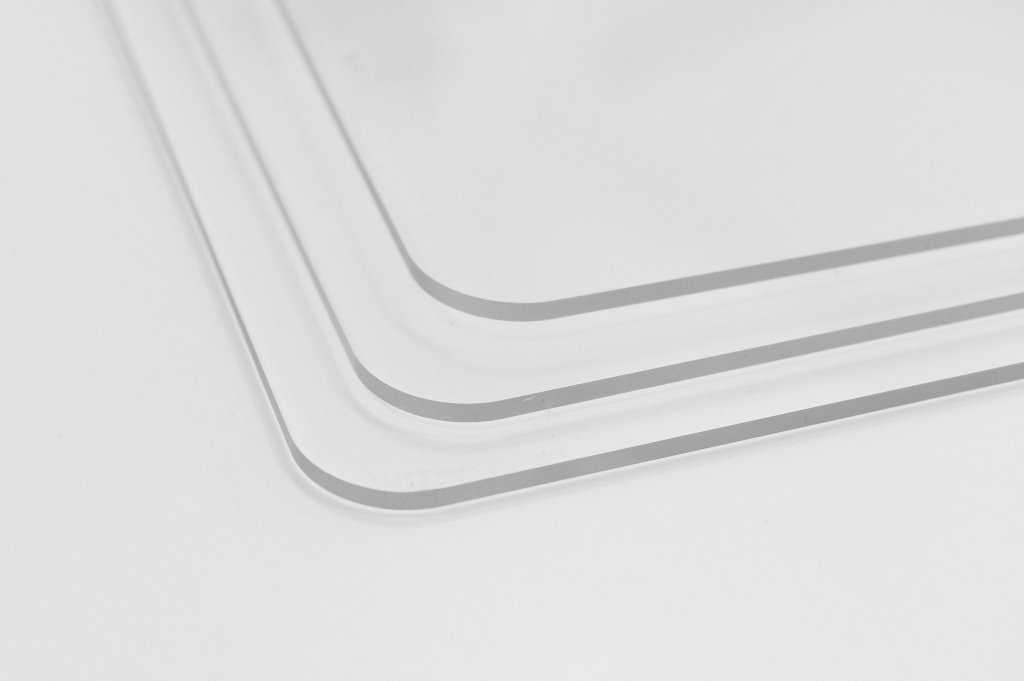Ever since clear acrylic came on the market, there has been the question of what is better—acrylic or glass?
Both have advantages and disadvantages, and much of the answer comes down to what you intend to do with the material. It also helps to understand what each is and what they offer.
What Is Glass?
Glass is a solid-like and transparent material made from natural raw materials such as sand, soda ash, and limestone. When these materials are melted at a very high temperature, they become structurally similar to liquid and be poured, blown, pressed, and molded into almost any shape. Once the molten glass reaches ambient temperatures, it behaves like a solid.
Glass can be found all around us. It’s used for windows, drinking vessels, picture frames, windshields, decorations, scientific equipment, optics, etc. As one of the most ubiquitous materials globally, all signs suggest it will continue to be a large part of daily life.
What Is Acrylic?
Also known as plexiglass, acrylic is a versatile plastic material available in various opacities and colors. It was first produced in 1928 and then introduced to the public by Rohm and Hass Company in 1933. Its first uses were for airplane windows, canopies, and observation domes during World War II. Acrylic is lightweight and durable, making it ideal for use in airplanes and many other trasnportation applications.
Acrylic today is available in many shapes and sizes and can be easily molded and colored to fit nearly any application. Common uses include windows, retail displays, aquariums, containers, greenhouse panels, and bulletproof glass.
The Advantages of Acrylic Over Glass
There are a number of significant advantages acrylic has over glass.
Light Weight – Where weight is a significant design factor, acrylic is likely the best choice as it generally weighs less than half of what glass of similar size would. As demands for efficiency and environmentally-conscious manufacturing increase, acrylic will likely become even lighter over time without loss of function, performance, or durability.
High Impact Resistance – It’s well-known that typical glass breaks relatively easily and that broken shards can result in serious injury. In contrast, acrylic has a significantly higher impact strength and does not shatter when exposed to stress or blunt force.
Lower Cost – While flat, unprocessed glass may be less expensive than acrylic, tempered glass tends to cost about the same. Formed and laminated glass costs notably more than acrylic due to the materials needed for forming. Glass usually requires steel or ceramic, while acrylic only needs fiberglass-reinforced resin. As technology improves, the price difference between acrylic and glass will continue to shift in acrylic’s favor.
Versatility – Glass manufacturers can form glass into curved shapes, but there are certain limits to what can be done. On the other hand, acrylic can be formed into almost any shape with relative ease without significant loss of optical properties. Also, because acrylic can withstand more pressure, acrylic windows or windshields are easier and safer to install than glass. After installation, they’re also much less likely to suffer from cracks.
Better Performance – Acrylic transmits more light than glass. While heat-hardened glass only transmits between 80–90% of all visible light, typical acrylic transmits up to 92%. Specific forms of acrylic can readily transmit visible light while also blocking out up to 99% of all UV light. Acrylic also has a lower thermal conductivity which means it insulates better than glass when used as windows and skylights. This can significantly benefit a building’s heating and cooling costs.
Marine Applications - In addition to offering the same benefits listed above, acrylic used in marine environments contiue to prove their worth. Many boaters and boat manufactuers are opting to use arcylic materials in place of traditioal glass becasue acrylic is fully capable of withstanding impacts and harsh weather condistions. In addition, acrylic boasts easy instalation, UV protection, better optical transmission, and thermal conductivity.
Is Acrylic As Scratch Resistant As Glass?
The main advantage of glass over acrylic is that glass is a bit more scratch-resistant. Acrylic’s softer surface can make it more vulnerable to scratches which can build up over time. However, with advancemnts in new technologies, new solutions are already being used to aleviate this disadvantge.
Already, silicate hard coatings to transparent acrylic add to its strength and resistance to surface blemishes. Additional refinements show that while acrylic may not be as scratch-resistant as glass, the gap is narrowing and rapidly approaching a state where the difference between acrylic and glass will be negligible.
Acrylic Sheet at Piedmont Plastics
Acrylic sheet from Piedmont Plastics is the finest choice for most manufacturing applications that require durability, clarity, protection, lightness, and low cost. When it comes down to it, an acrylic sheet is one of the most flexible materials currently available.
Contact our materials experts to determine how our acrylic solutions can help with your manufacturing project.
